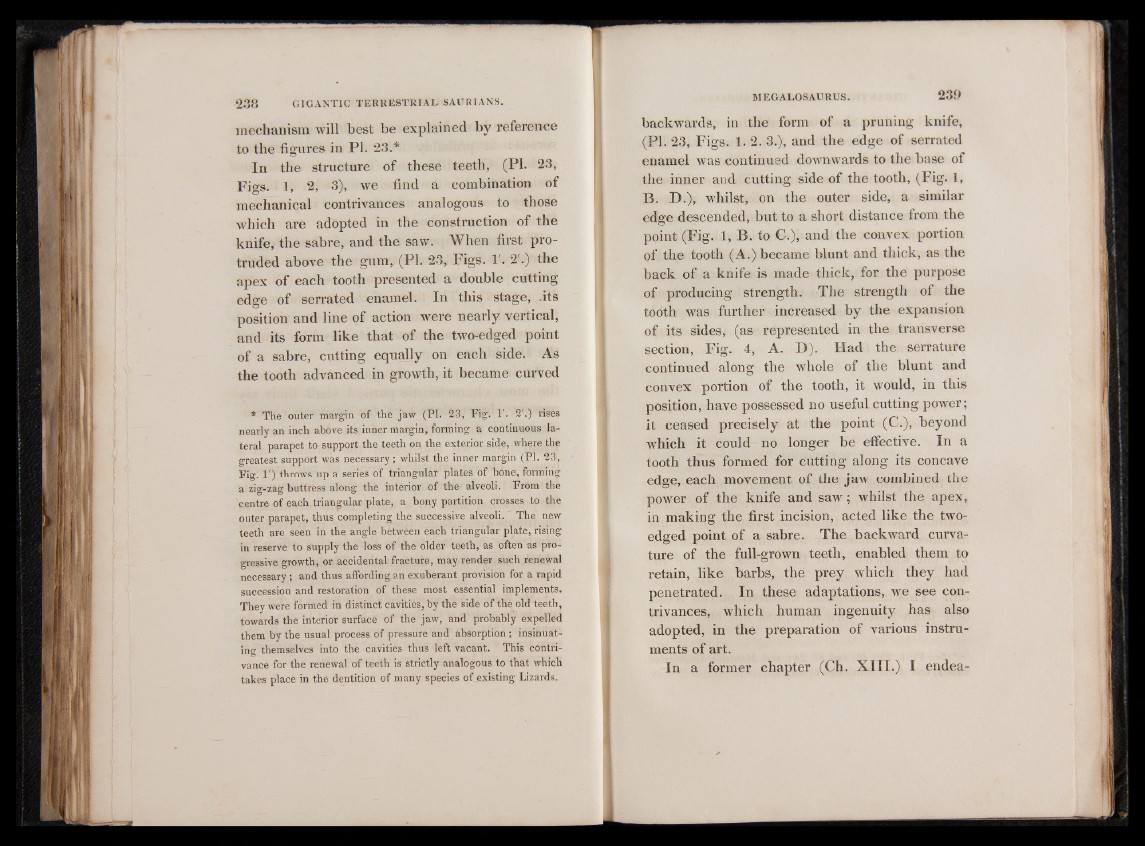
mechanism will best be explained by reference
to the figures in PI. 23.*
In the structure of these teeth, (PI. 23,
Figs. 1, 2, 3), we find a combination of
mechanical contrivances analogous to those
which are adopted in the construction of the
knife, the sabre, and the saw. When first protruded
above the gum, (PI. 23, Figs. 1'. 2'.) the
apex of each tooth presented a double cutting
edge of serrated enamel. In this stage, .its
position and line of action were nearly vertical,
and its form like that of the two-edged point
of a sabre, cutting equally on each side. As
the tooth advanced in growth, it became curved
* The outer margin of the jaw (PI. 23, Fig. 1'. 2'.) rises
nearly an inch above its inner margin, forming a continuous lateral
parapet to support the teeth on the exterior side, where the
greatest support was necessary; whilst the inner margin (PI. 23,
Fig. 1') throws up a series of triangular plates of bone, forming
a zig-zag buttress along the interior of the alveoli. From the
centre of each triangular plate, a bony partition crosses to the
outer parapet, thus completing the successive alveoli. The new
teeth are seen in the angle between each triangular plate, rising
in reserve to supply the loss of the older teeth, as often as progressive
growth, or accidental fracture, may render such renewal
necessary ; and thus affording an exuberant provision for a rapid
succession and restoration of these most essential implements.
They were formed in distinct cavities, by the side of the old teeth,
towards the interior surface of the jaw, and probably expelled
them by the usual process of pressure and absorption ; insinuating
themselves into the cavities thus left vacant. This contrivance
for the renewal of teeth is strictly analogous to that which
takes place in the dentition of many species of existing Lizards.
backwards, in the form of a pruning knife,
(PI. 23, Figs. 1. 2. 3.), and the edge of serrated
enamel was continued downwards to the base of
the inner and cutting side of the tooth, (Fig. 1,
B. D.), whilst, on the outer side, a similar
edge descended, but to a short distance from the
point (Fig. 1, B. to C.), and the convex portion
of the tooth (A.) became blunt and thick, as the
back of a knife is made thick, for the purpose
of producing strength. The strength of the
tooth was further increased by the expansion
of its sides, (as represented in the transverse
section, Fig. 4, A. D). Had the serrature
continued along the whole of the blunt and
convex portion of the tooth, it would, in this
position, have possessed no useful cutting power;
it ceased precisely at the point (C.), beyond
which it could no longer be effective. In a
tooth thus formed for cutting along its concave
edge, each movement of the jaw combined the
power of the knife and saw; whilst the apex,
in making the first incision, acted like the two-
edged point of a sabre. The backward curvature
of the full-grown teeth, enabled them to
retain, like barbs, the prey which they had
penetrated. In these adaptations, we see contrivances,
which human ingenuity has also
adopted, in the preparation of various instruments
of art.
In a former chapter (Ch. XIII.) I endea